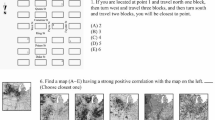Abstract
As a consequence of a recent reform of junior secondary education in the Netherlands, instruments for the assessment of cognitive abilities of students who are eligible for special educational support must be designed. In constructing a new test battery contemporary theory on crystallized and fluid intelligence (Gf-Gc theory) was considered. Complete coverage of the factors in Gf-Gc theory was not striven for, because the status of some of these factors in relation to referral to education with special educational support is not entirely clear. The sample in the study consisted of students from regular and special primary as well as secondary education, aged between 11 and 15 years. Approximately two-thirds of the sample was of Dutch origin, whereas the remaining third was of a different ethnic origin. Results show that the factors verbal-crystallized ability, fluid-reasoning ability, spatial-visualization ability and memory capacity can explain the positive correlations between the tests in the battery for the greater part. Students from regular and special education can be distinguished on the basis of their cognitive profiles reasonably accurate, thus supporting the criterion validity of the test battery. Students requiring special educational support are characterized by a significant discrepancy between short-term recall and long-term retention and retrieval.
Résumé
Une des conséquences de la réforme récente de l’enseignement secondair aux Pays-Bas est la nécessité de développer des instruments pour l’évaluation des capacités cognitives des enfants qui ont besoin d’un enseignement spécial. Dans la construction d’un nouvel ensemble de tests on a tenu compte de la théorie contemporaine qui fait une distinction entre l’intelligence cristallisée et l’intelligence fluide (la théorie Gf-Gc). On n’a pas cherché à couvrir tous les facteurs de la théorie Gf-Gc, parce que le rôle de ces facteurs dans la décision d’orientation d’un enfant vers l’enseignement spécial n’est pas tout à fait clair. L’âge des enfants sélectionnés pour cette recherche était de 11 à 15 ans. C’étaient des él’`eves de l’enseignement primaire et secondaire, général et spécial. Les deux tiers environ des enfants étaient d’origine hollandaise, les autres étaient d’une autre origine ethnique. Les résultats ont montré que les facteurs de la capacité verbale-cristallisée, la capacité de raisonnement-fluide, la capacité spatiale-visuelle et la capacité de la mémoire peuvent expliquer en bonne partie les corrélations positives entre les tests. Le profil cognitif permet de déterminer de façon raisonnablement précise l’orientation d’un enfant vers l’enseignement général ou spécial. Ce résultat confirme la validité-critère de l’ensemble des tests. Un décalage significatif entre les performances de la mémpire à court terme et de la mémoire à long terme caractérise les enfants qui ont besoin du soutien de l’enseignement spécial.
Similar content being viewed by others
References
Arbuckle, J.L. (1994). AMOS: Analysis of Moment Structures.Psychometrika, 59, 135–138.
Bentler, P.M. (1993).EQS. Structural Equations Program Manual. Los Angeles: BMDP Statistical Software Inc.
Carroll, J.B. (1993).Human cognitive abilities. A survey of factor-analytic studies. Cambridge: Cambridge University Press.
Cattell, R.B. (1963). Theory of fluid and crystallized intelligence: A critical experiment.Journal of Educational Psychology 54, 1–22.
Flanagan, D.P., & McGrew, K.S. (1998). Interpreting Intelligence Tests from ContemporaryGf-Gc Theory: Joint Confirmatory Factor Analysis of the WJ-R and KAIT in a Non-White Sample.Journal of School Psychology, 36, 151–182.
Guilford, J.P. (1967).The nature of human intelligence. New York: McGraw-Hill.
Horn, J.L. (1994). Theory of fluid and crystallized intelligence. In R.J. Sternberg (Ed.),Encyclopedia of human intelligence (pp. 443–451). New York: Prentice Hall.
Horn, J.L., & Cattell, R.B. (1966). Refinement and test of the theory of fluid and crystallized general intelligences.Journal of Educational Psychology, 57, 253–270.
Horn, J.L., & Noll, J. (1997). Human Cognitive Abilities: Gf-Gc Theory. In D.P. Flanagan, J.L. Genshaft & P.L. Harrison (Eds.),Contemporary Intellectual Assessment. Theories, Tests and Issues (pp. 53–91), New York: The Guilford Press.
Jöreskog, K.G., & Sörbom, D. (1988).LISREL 7. A Guide to the Program and Applications, Chicago: SPSS Inc.
Kaufman, A.S. (2000). Intelligence tests and school psychology: predicting the future by studying the past.Psychology in the Schools, 37, 7–16.
Koornstra, M.J., Neuwahl, N.M.E., & van Hoorn, W. (1979).IBO Differentiatietest. Handleiding [IBO Differentiation test. Manual]. Lisse: Swets & Zeitlinger.
Lohman, D.F. (1989). Human intelligence: An introduction to advances in theory and research.Review of Educational Research, 59, 333–373.
Meijer, C.J.W.E. (1998).Integration in Europe: Provision for Pupils with Special Educational Needs. Trends in 14 European Countries. Middelfart: European Agency for Development in Special Needs Education.
Neisser, U., Boodoo, G., Bouchard, T.J., Boykin, A.W., Brody, N., Ceci, S.J., Halpern, D.F., Loehlin, J.C., Perloff, R., Sternberg, R.J., & Urbina, S. (1996). Intelligence: Knowns and Unknowns.American Psychologist, 51, 77–101.
Oostdam, R.J., Meijer, J., Van Room, W., Den Brinker, W.H.P., & Van der Sluis, S. (2000).Nederlandse Differentiatie Testserie. Amsterdam: SCO-Kohnstamm Instituut.
Schutz, R.E. (1958). Factorial validity of the Holzinger-Crowder Uni-Factor Tests.Educational and Psychological Measurement, 18, 873–875.
Spearman, C. (1927).The abilities of man: Their nature and measurement. New York: MacMillan.
Swanson, H.L. (1994). The Role of Working Memory and Dynamic Assessment in the Classification of Children With Learning Disabilities.Learning Disabilities Research andPractice, 9, 190–202.
Thurstone, L.L. (1938).Primary mental abilities. Psychmetric Monographs (No. 1), Chicago: University of Chicago Press.
Verhoeven, L., & Vermeer, A. (1986)Taaltoets Allochtone Kinderen [Language test for migrant children]. Tilburg: Zwijssen.
Author information
Authors and Affiliations
Corresponding author
Additional information
This research was funded by the Dutch Ministry of Education, Culture and Science.
Rights and permissions
About this article
Cite this article
Meijer, J., Oostdam, R. The factor structure and criterion validity of a test for assessment of cognitive abilities. Comparing students in special and regular education. Eur J Psychol Educ 16, 531–547 (2001). https://doi.org/10.1007/BF03173196
Received:
Revised:
Issue Date:
DOI: https://doi.org/10.1007/BF03173196




